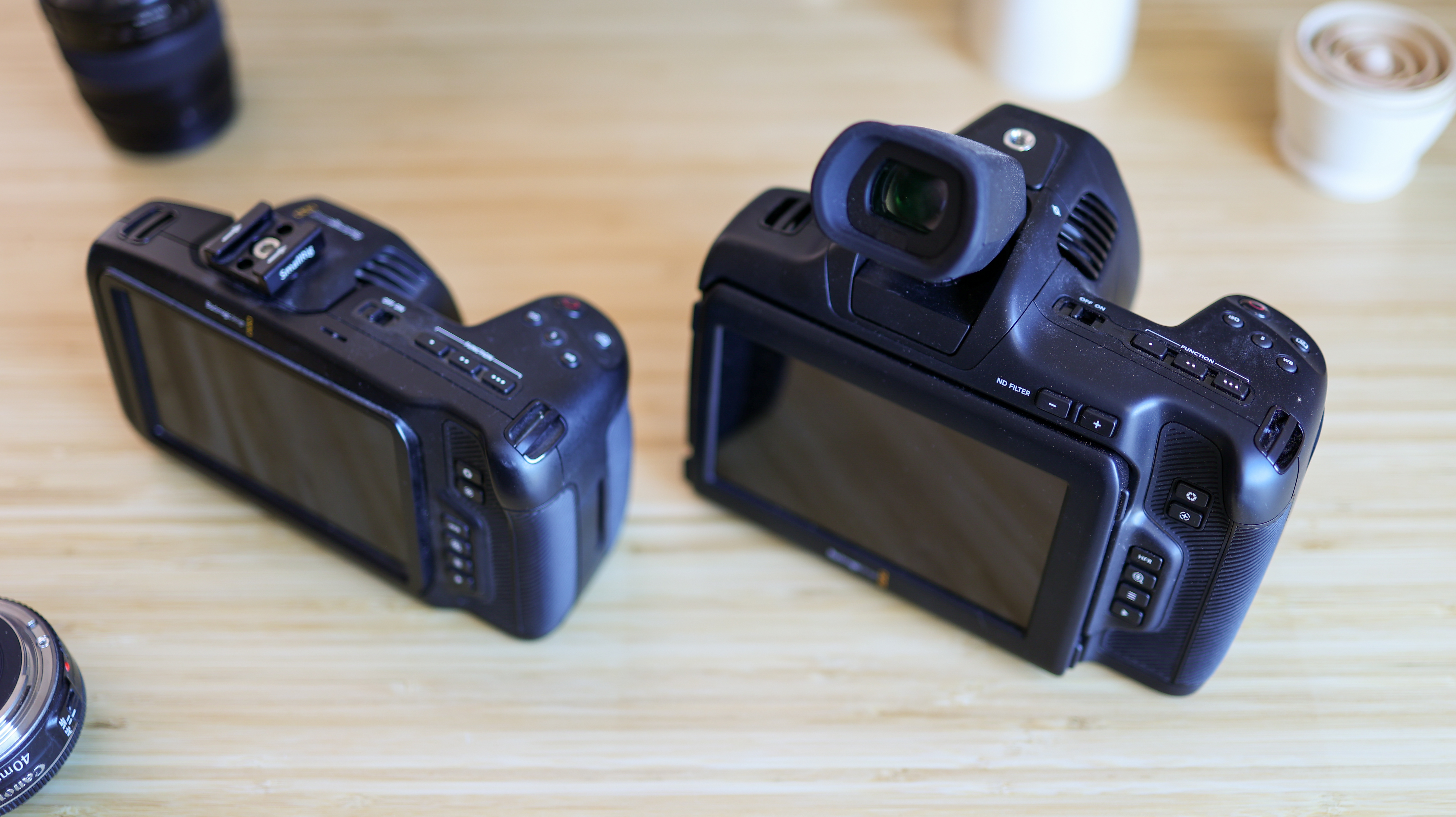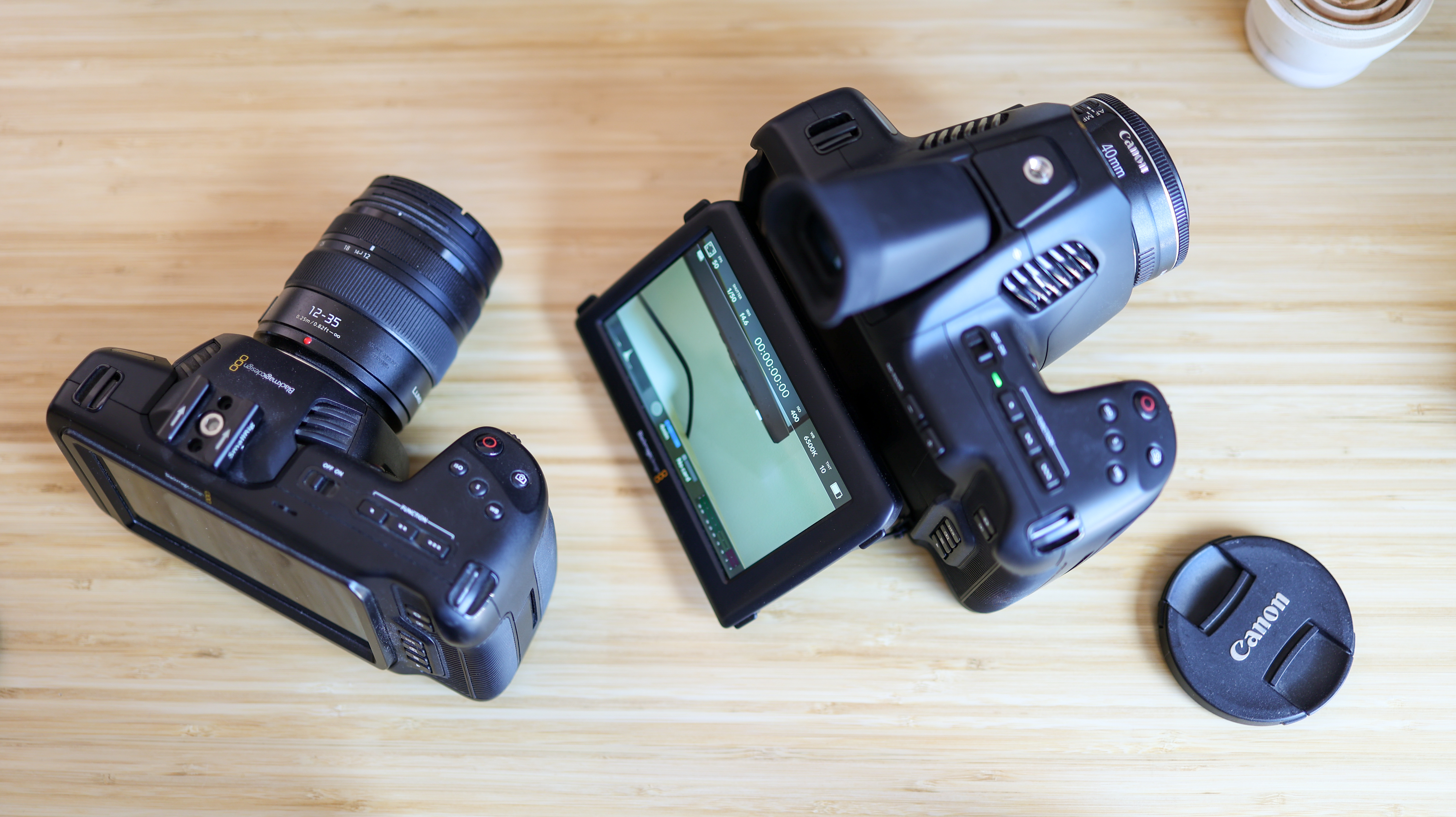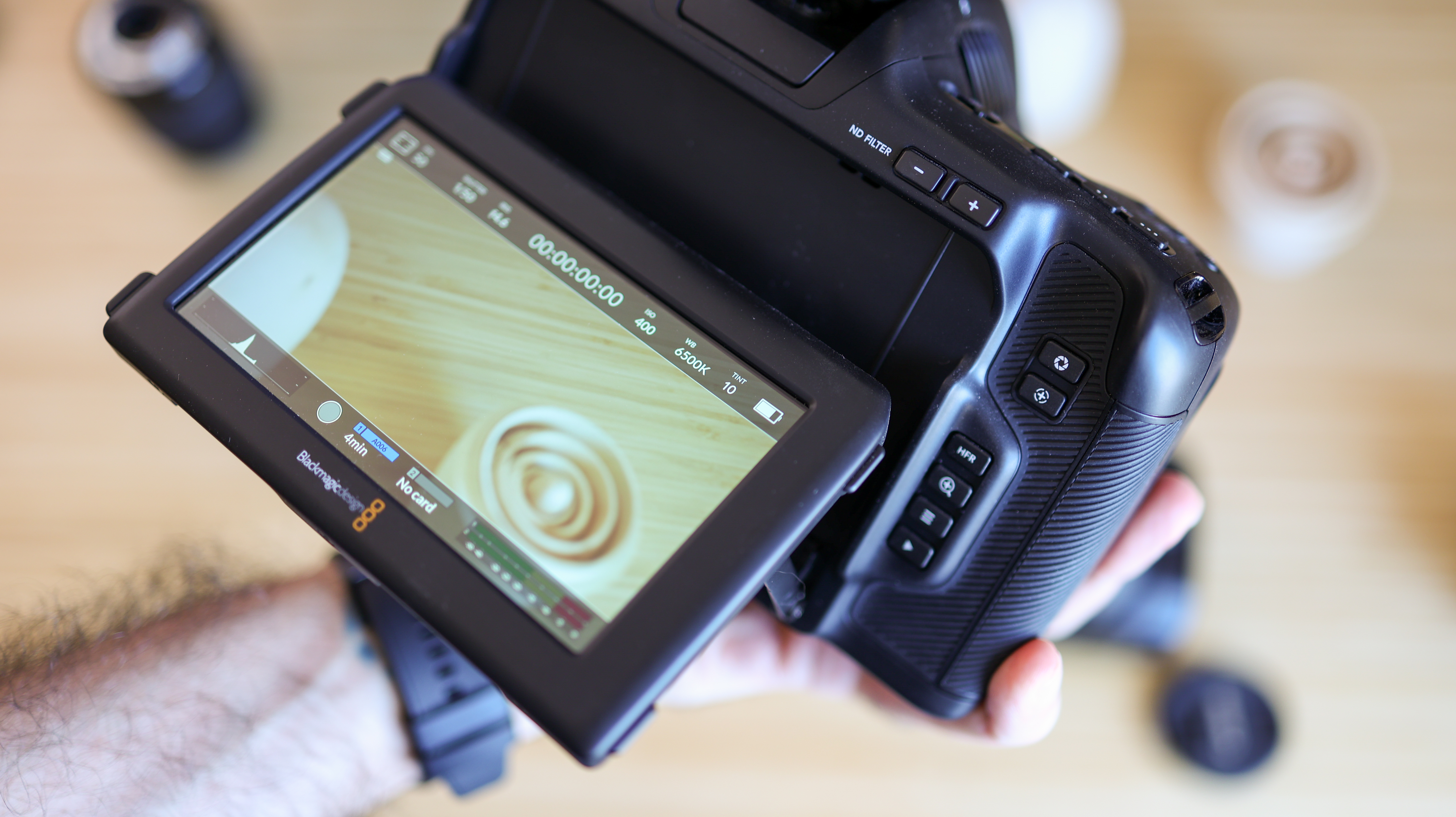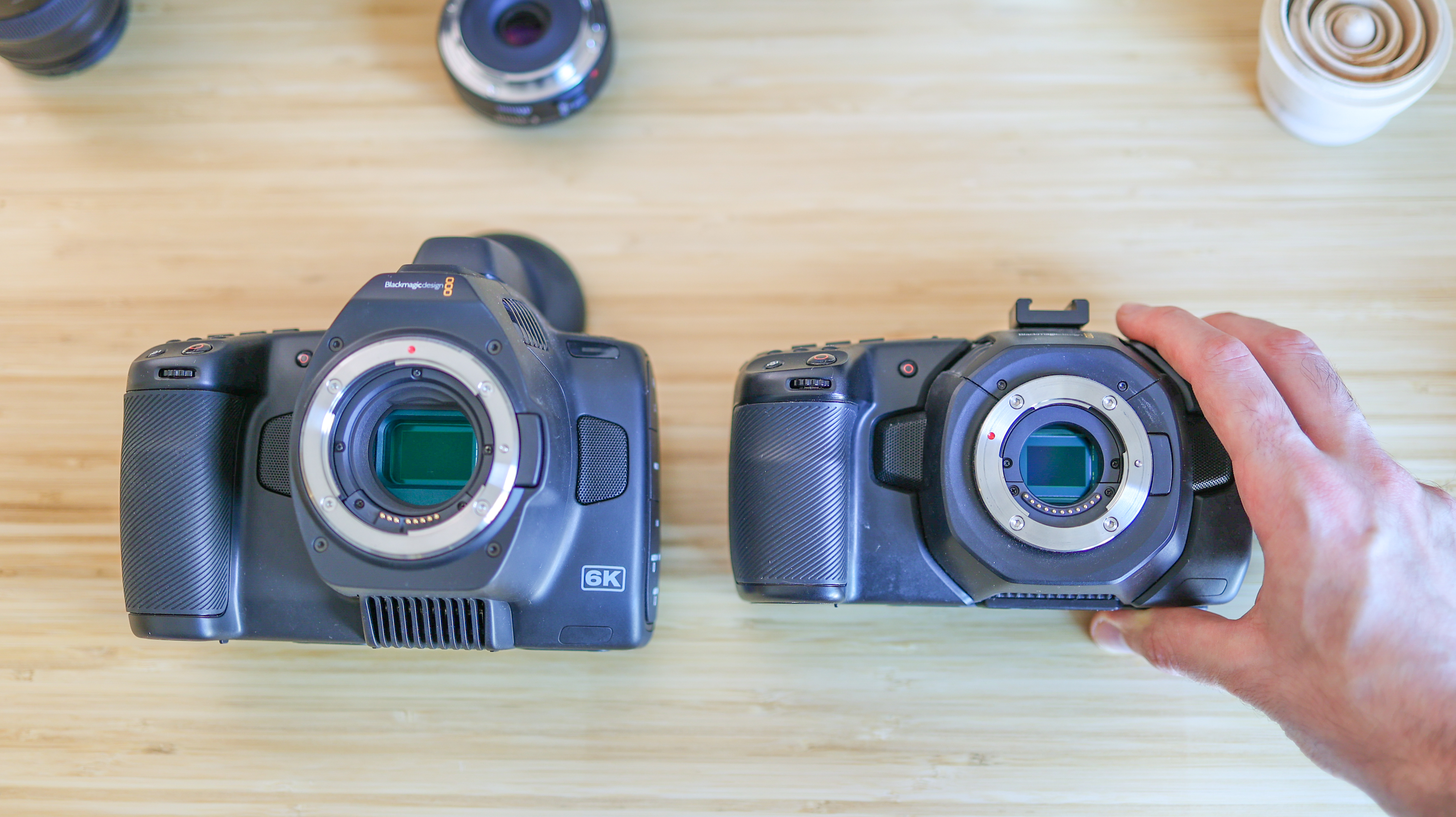The new Blackmagic Pocket Cinema Camera 6K Pro and its older BMPCC 4K sibling are two of the most compelling video cameras around right now – with the 4K version offering ultimate value, and the 6K Pro ultimate versatility. But which is the best model for you? There's certainly a big price disparity between them, with the 6K Pro cost around $1,000 / £1,000 more than the 4K version. But there's also plenty to differentiate the two and, in the case of the 6K Pro, potentially justify that extra cost. The Blackmagic Pocket Cinema Camera line may never have actually been pocketable, but it's always represented exceptional value for prosumer videographers looking to capture cinematic footage without spending the earth. At the heart of the Pocket Cinema Camera experience is an exceptional array of ports, including a mini XLR for audio (one on the 4K, two on the 6K Pro), a full-sized HDMI port, 3.5mm line-in, headphone out, and support for high-speed (and high-cost) CFast 2.0 cards, or more affordable SD cards. The two cameras also share many of the same shortcomings. Neither, for example, deliver battery life that can hold a candle to the Sony A7S III or Sony FX3. Additionally, no Blackmagic Pocket Cinema Camera has a fully articulating screen, something that will put off vloggers instantly. Need continuous autofocus? Then you need to look elsewhere. For everything the Blackmagic Pocket 4K and 6K Pro can do, they can't lock onto a subject or elegantly focus mid-capture. From a practical specs and usability point of view, though, there are seven key differences between the Blackmagic Pocket Cinema Camera 4K and 6K Pro other than price which will dictate which is right for you... Neither camera is pocketable, but the 6K Pro is chunky Neither the Pocket Cinema Camera 4K or 6K Pro are compact, but if you want the more convenient option, the 4K is it. Hardly surprising, given the fact it sports a smaller sensor, fewer mechanical features, a fixed screen, and one less port. The size difference between the 4K and 6K Pro mean accessories for one won't fit the other, and cases and bags might also not fit both cameras either. Getting into specifics, the 4K weighs a light 722g, while the 6K Pro comes in at 1.24kg. Neither camera is weather-sealed, and both sport plastic bodies, so could have been significantly heavier, but the 6K Pro is the weightier option. It's also over 2.5cm taller at 12.3cm, and almost 3cm deeper, than its sibling. That said, the two cameras are roughly the same width, so if you have a horizontal open-top cage, it could be compatible with both. The 6K Pro's sensor is both larger and higher resolution The Blackmagic Pocket Cinema Camera 4K sports a Micro Four Thirds sensor (18.96mm x 10mm), which is physically smaller than the Super 35mm chip (23.1m x 12.9mm) in the 6K Pro. As the name suggests, it also shoots at a different maximum capture resolution, with the 4K capturing footage at up to 4096 x 2160, and the 6K Pro shooting at up to 6144 x 3456. This sensor size difference also results in a different crop-factor, with the Blackmagic Pocket Cinema Camera 4K giving you a 1.9x crop, while the 6K delivers a wider 1.56x crop. Depending on what you love to shoot, this will affect you differently; wide-angle lovers who will want maximum information in-frame will prefer the 6K Pro, whereas anyone who needs maximum reach at 4K could be well-served with the more affordable Pocket Cinema Camera 4K. The 6K Pro's screen is brighter and flips, unlike the 4K's fixed display... At 5-inches and with a resolution of 1920 x 1080, the Pocket Cinema Camera line’s display betters all mirrorless camera competition by delivering a size and aspect ratio that’s perfect for video capture (why the Sony FX3 still sports a 4:3 screen is beyond us). That said, the LCD quality of the Pocket Cinema Camera 4K’s screen isn't great, with a dim picture even at peak brightness. Additionally, the 4K screen is fixed in place. Thankfully, Blackmagic Design boosted the display quality in its 2021 Cinema Camera, with the 6K Pro’s brightness climbing up to a generous 1,500 nits for easier viewing outdoors and in bright environments. Not stopping there, the 6K Pro also sports a tilting screen design, similar to that found on the Sony A6600, which, while not fully articulating, still does a great job of adding convenience when shooting at awkward angles. Similar battery lives, despite the switch from Canon to Sony... Both the Blackmagic Pocket Cinema Camera 4K and 6K support 2,000mAh Canon LP-E6 batteries, which have been keeping DSLRs alive in excess of 15 years. The official battery life quoted by Blackmagic for the 4K is 60 minutes on a single charge when shooting at 24fps, however, we found real-world use was significantly less with our preferred settings, nearer 40 minutes. With its brighter screen and higher resolution, the power draw from the 6K Pro is inevitably greater, so Blackmagic has switched out to another popular battery type this time around, opting for a 3,500mAh NF-F570. If you don’t recognize the name, NF-F570s have the same fit as the batteries used by Atomos Ninja 5 devices, and many lights, so there’s a good chance you’ve got a few larger variants in your kit bag. The result is a similar run time across the 4K and 6K Pro, despite the latter’s boosted specs. The 6K Pro's optional OLED viewfinder (sold separately) is a bonus... Calling the Blackmagic Pocket Cinema Camera 4K modular is a stretch. With a smart rig, sure, you could cage it and hook up external storage, a monitor, a shotgun mic or a wireless receiver, but Blackmagic’s first-party solutions are few and far between, consisting of a battery grip and that’s about it. The Blackmagic 6K Pro has been created to be kitted out a bit more than the 4K or vanilla 6K from the offset. In addition to a more elegant battery grip solution, which connects with pogo pins rather than a dummy battery, you can grab an OLED electronic viewfinder (EVF) for it too. With a four-element glass diopter, the EVF sports adjustment levels from -4 to +4, displays built-in status information, and is plug-and-play. It can also be controlled from the 6K Pro’s touch UI, with brightness and display information being nicely customizable. The 6K Pro's ND filters are one of its biggest upgrades... Fire up the Blackmagic Pocket Cinema Camera 6K Pro, push the + or - buttons on the back of the camera, and you’ll activate what could be its best upgrade over the original Pocket Cinema Camera 4K and 6K – the four-position ND filter. Whichever button you press, - or +, you’ll cycle through either zero-stop (no filter), two-stop, four-stop and six-stop IR ND filters, which electronically slide in front of the sensor. This feature alone could put the Pocket Cinema Camera ahead of much pricier competition like the Sony FX3, saving much faffing with screw-on lens-specific filters. Micro Four Thirds versus Canon could be the big deciding factor... There's something to be said for buying a camera that plays nicely with your existing lens collection, and if you're anything like us, a big deciding-factor between the Blackmagic Pocket Cinema Camera 4K and 6K Pro will be the glass you own. The Pocket Cinema Camera 4K uses Micro Four Thirds lenses, so will work perfectly for anyone coming from a Panasonic G-series or Olympus mirrorless camera, for example. Just like the Pocket Cinema Camera 6K, the 6K Pro has an active Canon EF mount, so engages autofocus and a wider collection of photography and cinema lenses without the need for an adapter. Whichever option you go for, Blackmagic’s Pocket Cinema Camera line is unbeatable when it comes to video quality bang for buck. The 4K may not pull the shallow depth of field or resolution of the 6K Pro, but you can get some stellar value lenses for it and it’s more affordable and compact. Meanwhile, if you can afford to spend the extra, it’s no mystery where the Pocket 6K Pro’s additional value is added, from the shooting resolution to the in-body ND filters, the tilting screen with a brighter picture, through to the optional EVF.
Blackmagic Pocket Cinema Camera 6K Pro vs BMPCC 4K: the seven key differences
1. Size

2. Sensor

3. Screen

4. Battery life
5. EVF

6. ND filters

7. Lens mount

source https://www.techradar.com/news/blackmagic-pocket-cinema-camera-6k-pro-vs-bmpcc-4k-whats-the-best-video-camera/
Rule #21 of the internet: Original content is original only for a few seconds before getting old.


